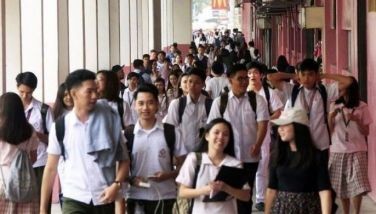Year of Edsa I, Asiad and The STAR
MANILA, Philippines - The first issue of The Philippine STAR hit the streets on July 28, 1986. It was five months after the first EDSA People Power Revolution.
From December 1985, when then plain citizen Corazon C. Aquino decided to oppose Ferdinand Marcos in the snap presidential elections that the dictator called at the behest of the US Government to secure a new mandate, to the day the Marcoses fled on February 25, I had the chance to work with future Philippine Star co-founder Betty Go-Belmonte and future STAR editor Joanne Ramirez at the Cory Aquino Media Bureau.
The Media Bureau, as candidate Cory’s media group was called, fed both the so-called “mosquito” or “alternative” press and the Marcos government-controlled media with accounts of how the opposition was conducting its people-powered campaign against the National Treasury-subsidized machine of Marcos.
Running on a shoestring budget, members of the Media Bureau that included, among others, Teddy Boy Locsin, Raul Contreras, now STAR columnist Billy Esposo, Ching Montinola and Ed Zialcita, had a daily diet of tuna sandwich and occasionally, pancit and pizza and, at times, faced possible raids by government authorities. Several times, subversive literature mysteriously found their way into the Media Bureau, obviously planted by unknown parties as part of the grand scheme of painting the opposition as communist sympathizers.
A few months after EDSA, Mrs. Belmontee, Max Soliven and Art Borjal decided to set up The Philippine Star and on July 28, 1986 came up with the initial run of only “a few thousand copies” without advertising.
By 1989, through hard work and a lot of prayers, The STAR rose to become one of the highest selling broadsheets in the country and one of the few to survive a very competitive environment that produced so many dailies powered by the country’s newfound freedom. In 1989, Betty called to ask me to write for The STAR, but that is going ahead of the story.
The 1986 Seoul Asian Games, which the South Koreans used as a dress rehearsal for the 1988 Seoul Olympics, was the first Olympic-type sports competitions where the new free Philippines would take part. Fresh from the peaceful EDSA revolution, the Filipinos offered hope to the host Koreans who were themselves trying to escape the grip of an authoritarian military regime.
The regime had been hoping to use the Asian Games and the Olympics to get badly-needed credibility and international acceptance. In hosting however the two high-profile events, Korea’s rulers merely succeeded in opening themselves to international scrutiny that unwrapped in full view their various anti-democratic and abusive practices.
When the Philippine delegation marched into the 10th Asian Games venue, the Olympic Stadium, for the opening ceremonies on September 20, 1986, the Filipinos were greeted with a thundering, standing ovation befitting heroes by the 100,000 spectators that filled the stadium.
Twenty-five nations took part in the 1986 Asiad with 4835 athletes competing in 25 sports/events.
The Philippines fared very well in the 1986 Asian Games compared with our most recent performances over the last several years. The country finished sixth place in the overall standings with 18 medals behind China, South Korea, Japan, Iran and India, although Thailand had 26 medals to occupy seventh place. The Filipinos however had four gold medals to Thailand’s three.
The Philippines won two gold medals in tenpin bowling, one each in golf and athletics, the latter courtesy of then Asia’s fastest woman, Lydia de Vega. The most dramatic performance was turned in by de Vega who beat archrival, P.T. Usha of India in athletics’ premiere event, the 100-meter run with a time of 11.53 secs. Usha clocked 11.67 but returned to outsprint de Vega in the 200 meters with a time of 23.44 to de Vega’s 23.47. Usha would later capture the gold medal in the 400 meters, with a time of 52.16, to emphasize her versatility and athleticism.
Back in the home front, in 1986, the De La Salle Green Archers were finally accepted as a member of the University Athletic Association of the Philippines (UAAP), after being without a league for several years having left the National Collegiate Athletic Association (NCAA) after a tumultuous basketball game against Letran at the Rizal Memorial basketball coliseum. In 1989, the Green Archers won the first of its seven UAAP basketball titles.
Over at the NCAA, 1986 marked the return of San Beda College to the league after taking a leave in 1983 “in order to focus on school-based sports activities like intramurals” as stated by the school paper, The Bedan in an article entitled, “NCAA: An Endless Saga” in its June 2005 issue.
1986 was marked by the great miracle of People Power and some great feats in Philippine sports. It also marked the start of an enterprise put together by a hardy bunch of freedom fighters.
- Latest
- Trending





























